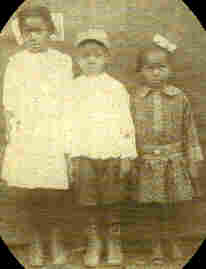
|
|
Reflections:
A Look Back --A 1960's Perspective
The ultimate measure of a man is not where he stands in moments of comfort, but where he stands at times of challenge and controversy. -- Dr. Martin Luther King, Jr.
|
 Amy, Walter & Rosa Johnson, about 1917.
Amy, Walter & Rosa Johnson, about 1917. |
|
The Elaine Race Riots of 1919 by O.A. Rogers, Jr. Phillips County is bounded on the east by the Mississippi River, which separates it from the State of Mississippi, on the south by Desha County; on the west by the counties of Arkansas and Monroe: and on the north by Lee County--all rich delta land. The general section was commonly referred to as the Black Belt since there was a high concentration of Negroes, many of whom were sharecroppers and tenants on numerous plantations found in that region. In 1910, the county had a population of 26,354 Negroes and only 7,176 white people. Thus about 78.6 per cent of the total population was Negro. The land was devoted to the raising of cotton on the plantation system--the land was owned by the whites and most of the labor was performed by the Negroes.
|
|
Be sure to stop by your local library to check out a copy of Along the Way, James Weldon Johnson's 1933 autobiography. Well known for having penned "Lift Evr'y Voice & Sing", Johnson devoted a couple of pages in his autobiography to "The Red Summer" in Phillips County.
For more information about Phillips County's present and past...
Search Your Phillips County Roots
The Daily World Newspaper
|
Sharecropping---
The Negroes had been having trouble in getting settlements for the cotton they raised on land owned by whites. Both the Negroes and the white owners were to share the profits when the crop was sold for the year. Between the time of planting and selling, the sharecroppers took up food, clothing, and necessities at excessive prices from the plantation store owned by the planter. It was not a practice of the landowner and the sharecroppers to go together to a market to dispose of the cotton when it was ready. Rather, the landowner sold the crop whenever and however he saw fit. At the time of settlement, neither an itemized statement of accounts owed nor an accounting of the money received for cotton and seed, was, in most cases, given or shown the Negroes. It was an unwritten law of the cotton country that they could not quit and leave a plantation until their debts were paid. Many Negroes in Phillips County whose cotton was sold in October, 1918, did not get a settlement before July of the following year.
|
___
Excerpts, above, are from the Summer, 1960 issue of the Arkansas Historical Quarterly. O.A. Rogers, Jr. was the President of the Arkansas Baptist College in Little Rock, Arkansas when he wrote the article.
|
|